
Vespula is a small genus of social wasps, widely distributed in the Northern Hemisphere. Along with members of their sister genus Dolichovespula, they are collectively known by the common name yellowjackets in North America. Vespula species have a shorter oculomalar space and a more pronounced tendency to nest underground than Dolichovespula.
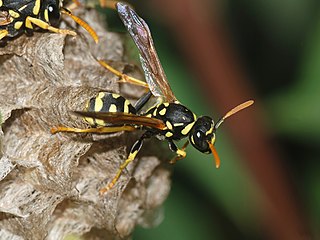
Polistes is a cosmopolitan genus of paper wasps and the only genus in the tribe Polistini. Vernacular names for the genus include umbrella wasps, coined by Walter Ebeling in 1975 to distinguish it from other types of paper wasp, in reference to the form of their nests, and umbrella paper wasps. Polistes is the single largest genus within the family Vespidae, with over 200 recognized species. Their innate preferences for nest-building sites leads them to commonly build nests on human habitation, where they can be very unwelcome; although generally not aggressive, they can be provoked into defending their nests. All species are predatory, and they may consume large numbers of caterpillars, in which respect they are generally considered beneficial.

Commonly known as cuckoo wasps or emerald wasps, the hymenopteran family Chrysididae is a very large cosmopolitan group of parasitoid or kleptoparasitic wasps, often highly sculptured, with brilliant metallic colors created by structural coloration. They are most diverse in desert regions of the world, as they are typically associated with solitary bee and wasp species, which are also most diverse in such areas. Their brood parasitic lifestyle has led to the evolution of fascinating adaptations, including chemical mimicry of host odors by some species.

The superfamily Chrysidoidea is a very large cosmopolitan group, all of which are parasitoids or cleptoparasites of other insects. There are three large, common families and four small, rare families. Most species are small, almost never exceeding 15 mm. This superfamily is traditionally considered to be the basal taxon within the Aculeata, and, as such, some species can sting, though the venom is harmless to humans.

Dolichovespula is a small genus of social wasps distributed widely throughout the Northern Hemisphere. The yellow and black members of the genus are known by the common name yellowjackets in North America, such as Dolichovespula norwegica, along with members of their sister genus Vespula. In a study on the nesting biology of Dolichovespula, a colony of D. maculata with 771 workers was reported as having the largest recorded population count.

Chrysis is a very large genus of cuckoo wasps. It is the largest genus in the family, including over 1,000 species in over 20 subgenera, as speciose as all remaining Chrysididae combined. The generic name is derived from Greek chrysis, "gold vessel, gold-embroidered dress", and pays tribute to the brilliant metallic appearance of wasps in the genus.
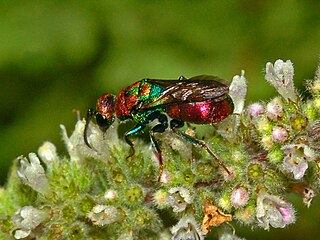
Hedychrum is a large genus of cuckoo wasps. With roughly 150 species, it is the second largest genus in the family; most species are from the Palaearctic, but they can be found in the Oriental, Afrotropical, Nearctic, and Neotropical regions. Their hosts are typically from the subfamily Philanthinae.
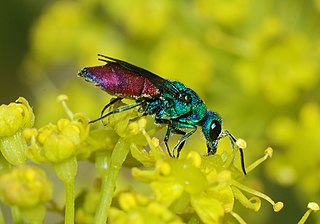
Chrysura is a genus of cuckoo wasps which parasitize megachilid bees. There are 117 species in Chrysura, all but 11 of which are found in the Palaearctic, making it the third largest genus in the family. The genus was described by Dahlbom in 1845, and the type species for the genus is Chrysura austriaca.

Hedychrum nobile is a species of cuckoo wasps.
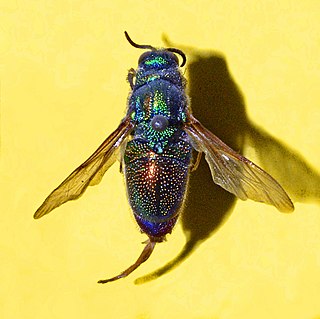
Stilbum is a genus of cuckoo wasp.
Polybioides is a genus of paper wasp of the sub-family Polistinae which contains six species which are found in the Neotropical, Afrotropical and Indomalayan zoogeographic regions.
Stigmus americanus is a species of aphid wasp in the family Crabronidae. It is found in North America.
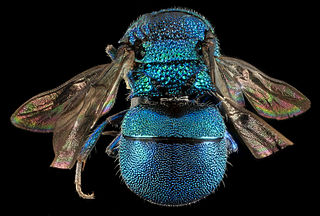
Elampini is a tribe of cuckoo wasps in the family Chrysididae.

Loboscelidiinae is a small subfamily of cuckoo wasps in the family Chrysididae. There are 2 genera and more than 40 described species in Loboscelidiinae, and they are parasitoids of walking stick eggs.

Parischnogaster is a genus of hover wasps from the subfamily Stenogastrinae, a subfamily of eusocial wasps endemic to the Oriental Region which are included in the family Vespidae.

Omalus aeneus is a species of cuckoo wasps belonging to the family Chrysididae.
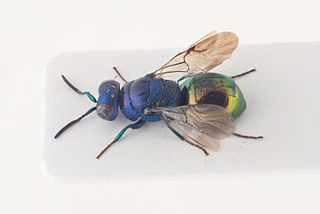
Omalus biaccinctus is a species of cuckoo wasps belonging to the family Chrysididae.

Omalus puncticollis is a species of insect belonging to the family Chrysididae.
Robert François du Buysson, was a French naturalist.
Ephippigerida is a genus of European bush crickets in the tribe Ephippigerini, first described by Ignacio Bolívar in 1903 as Uromenus (Ephippigerida). To date (2022) species have only been recorded from the Iberian peninsula.
















